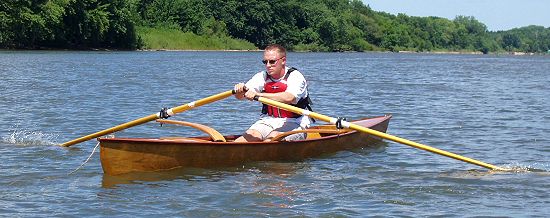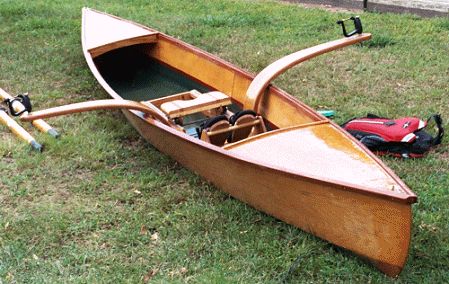
Dear 'Info'
Last summer, I finished the 'Sculling Skiff' using stitch and glue plywood construction. This is a picture of my son, Troy, moving through the water at a pretty good clip. The boat is so sleek that it leaves almost no wake.
The second picture was taken just before the DNR ranger showed up and asked: "Is this boat registered in Illinois?" My little plywood skiff now has a 12 digit hull identification number. Another DNR agent actually had to come to my garage to verify that it was home made. A lot of trouble for the $13 license fee.
Where we live, it is difficult to get marine-grade materials. For instance, I was only able to find one supplier that even carried 1/8" plywood, and that was interior grade*. But when it was covered in fiberglass and epoxy inside and out, it didn't really matter. The wood turned out so beautifully that I didn't need to paint the outside. The joint filler was white, so it was necessary to paint the inside bottom and up to 4" above the shear line. I made the riggers and sliding seat from scratch, but I had to buy the oars (they cost as much as the rest of the boat combined). There were just too many curves in too many planes for me.
The main problem with the skiff is that it is scary-fast. My son and I are the only ones willing to even get into it. The oars have a 19 foot wingspan, which gives tremendous leverage. Within 4 strokes, you can be going 4-5 miles an hour. That doesn't sound like a lot, but it is twice as fast as a canoe or kayak. If you catch an oar at that speed, bad things can happen in a big hurry.
Overall I found the plans to be well thought out and understandable. I learned a lot and would do a better job if I had the chance to do it over, but next time I am going to build a sailboat.
From a design standpoint, it would help if you could lower the seat an inch or two. With the current seat arrangement, your center of gravity is pretty high for such a short and narrow boat.
I am learning to handle my little skiff and getting more confident, but this is definitely not a boat for the timid. I don't know if I will ever get to the point where I will take it out so far that I can't swim back to shore!
Don Scribner
New Lenox, IL
* Note: We would not recommend using interior plywood. Yes, if no water gets to the inner plies, it may be all right, but should water get in through a small hole or other break in the surface, the boat could turn to rubber and there is no way to fix this. ...Glen-L
